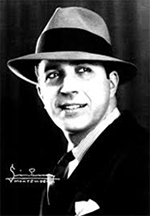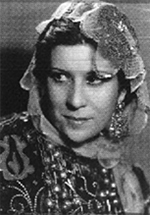| between Tango and Flamenco |
What would have happened if Tango idols Carlos Gardel and Flamenco dancer and singer "La Argentinita" ever met? It could have been possible, for example, in 1930 at the Café Royal Kursaal in Madrid or in 1932 on the steamship "Alcàntara", a "Transatlántico" on the way from Vigo to Buenos Aires or ...
Nobody knows if the meeting actually took place, but what does it matter? We add one more to the hundreds of legends spun around these two volumes and take this as a starting point for a fierce musical declaration of love between Tango and Flamenco.
For this project we can count on the cooperation of no less than
Omar Mollo, one of the most famous living Argentinian tango singers. With "Barrio Sur", he won the "Premio Carlos Gardel" for the best record of a male tango vocalist, with "Tangamente" closing him in 2016 and the album was also nominated for the Latin Grammy Award 2016. He does not have to look back at Gardel's oeuvre, it is simply a part of his life.
|
|
Flamenco dancer Irene Álvarez is not unknown (Carmen revisited with Tania Kroos, Musa, Esencial) and with her personal style, ranging from traditional Flamenco to Clásico Español, she is the ultimate dancers to explore the footsteps of "La Argentinita".
|
|
 |
Charles Romuald Gardès alias Carlos Gardel was born in 1890 in Toulouse, France, although he himself claimed that he had come to Uruguay in 1887. As an illegitimate child, he emigrated with his mother to Argentina, to the Abasto district in Buenos Aires.
In the neighbourhood there were also numerous cafes next to the big vegetable market, and Charles, who often explored and sang in the area, quickly rose to fame because of his beautiful voice. When Italian singer Titto Ruffo coincidentally heard him sing, he decided to help develop the voice of the then twelve-year-old boy.
At the age of sixteen, Charles fully committed himself to singing and acting in cafes
and restaurants. In 1912, a "Tango duel" took place with singer Josè Razzano, resulting in them becoming a very successful duo and ... Charles Romuald Gardès became Carlos Gardel.
In 1915, the duo was known far beyond the borders of Argentina when Gardel suffered a life-threatening injury because of a shooting in a club. He made his comeback in 1917, now solely on Tango and without Razzano, but with his artistic partner Alfredo Le Pera, poet and journalist, who wrote numerous lyrics for Gardel's music.
Together they made a lot of legendary Tangos, such as "Volver", "Mi Buenos Aires Querido", "Golondrinas", "El Dia Que Me Quieras" etc.
From 1925 onward, the European career of Gardel began and he became almost as famous in Spain as he was in Argentina.
From the thirties (with the rise of the films with sound), Gardel also worked as an actor and singer in a number of film productions in Argentina, the US and Spain.
In 1935 Carlos Gardel and Alfredo Le Pera died on a plane crash in Medellin (Colombia) during a tour of South America.
|
|
 |
„La Argentinita", in particular Encarnación López Júlvez, was born in 1897 in Buenos Aires, Argentina. In 1903, her parents returned to Spain and in Madrid began "La Argentinita", encouraged by her father to learn different dance styles: Flamenco, Clásico Español and folklore. From her eighth, she was on stage, initially as a big promise, later evolving into a celebrated star. 1920, after the death of her lover, the torero Joselito el Gallo, "La Argentinita" returned to Buenos Aires and travelled throughout South America with a number of artists. She came into contact with the group "Generación del 27" around the writers Federico García Lorca and Rafael Alberti and this led to a new chapter in her career. Her major breakthrough as a choreographer came from the production "El Amor Brujo", combining her stylized form of "Spanish Dance" with Flamenco and folklore.
Her recordings of the "Canciones Populares" with Federico García Lorca on the piano were a great international success and bridged the boundary between folk culture and classical music. After extensive tours in South America and the US, "La Argentinita" returned to Spain in 1936. During the outbreak of the civil war and after the murder of Lorca, she fled into a dramatic journey through Morocco, France, Belgium and the Netherlands to New York. In 1943, her production "El Café de Chinitas" was performed with great success in the Metropolitan Opera House, this with the New York Philharmonic under the direction of José Iturbi and with decors by Sálvador Dalí.
"La Argentinita" died in 1945 due to the consequences of a cancer operation.
In the wake of the "gitanismo" (based on various books about the 1960s and 1970s Flamenco), this period is often mockingly called “the opera flamenca” and linked to the commercialization and dilution of flamenco.
In addition, it is forgotten that "La Argentinita" and her sister Pilar López laid the foundation and opened the doors to the international success of Flamenco and a development through José Greco, Vicente Escudero, Antonio Gádes and Mario Maya directly to the current avant-garde leads: to Israel Galván and Rocío Molina.
|
|
How does tango actually connect with Flamenco?
-the Spanish language
-their origin in the folksy, often originating from the marginal social classes of society.
-The intention to touch the listener as direct and as deep as possible through an emotional interpretation.
-The inherent nostalgia, with Tango, this is evident; with Flamenco the nostalgia is a bit more subtle, for example, you find them back in the jaleos. On a recording of Tomas Pavón from the 20's, you hear a voice in the background that says "Vamos a escuchar al cante flamenco que ya no existe" (we are listening to the true flamenco song that no longer exists). The regret of a lost pure version of flamenco is just a part of the flamenco, of its romantic perception. This is actually a paradox, because flamenco has been fusion of various musical styles, from the beginning.
„Transatlánticos“ is not a linear story about the lives of Gardel and
"La Argentinita", their oeuvres, biographical data and anecdotes form the foundations and act as a source of inspiration for what will eventually happen between the musicians on stage.
|
|
|
|